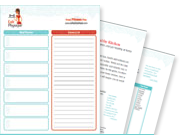Traditionally, healthy eating has required folks to devote a huge chunk of their paychecks to buying groceries, but with a little smart shopping (and some time spent pre-planning), it IS possible to eat well on a budget.
Main Course
Jennifer May, and RD with Dietwatch.com, gives some great tips on how to shop for healthy foods without breaking the bank:
1) Cook from scratch as much as possible. Dinners in a box or a bag come with a hefty price tag and are not as tasty as homemade. Instead of buying frozen entrees, freeze your own leftovers to take to work and reheat for lunch.
2) Canned tuna, peanut butter, beans, and eggs are the cheapest protein sources, with poultry as the next best choice.
3) Plan at least one vegetarian meal per week. Not only will you save money, you’ll increase your intake of fruits, vegetables, beans, and grains. In general, your food dollars will stretch more if you treat meat as a condiment, not as the focus of the meal.
4) Buy fresh produce in season. Frozen produce is a good choice when fresh is too pricey or of poor quality—and again, you’ll save even more with store brands. Buy just what you’ll use to avoid waste. If you don’t already, make plans to grow your own.
5) Instead of buying a latte or cappuccino every morning, brew your own coffee or espresso at home. You’ll save money even if you use premium coffee beans. You can also save money (and get extra antioxidants) by choosing iced tea over soda.
6) Be willing to sacrifice convenience. Wash and slice your vegetables instead of buying pre-bagged versions. Skin and debone your poultry.
7) Snack on fresh fruits and vegetables, yogurt, high-fiber cereal, and hot-air popped popcorn.
2) Canned tuna, peanut butter, beans, and eggs are the cheapest protein sources, with poultry as the next best choice.
3) Plan at least one vegetarian meal per week. Not only will you save money, you’ll increase your intake of fruits, vegetables, beans, and grains. In general, your food dollars will stretch more if you treat meat as a condiment, not as the focus of the meal.
4) Buy fresh produce in season. Frozen produce is a good choice when fresh is too pricey or of poor quality—and again, you’ll save even more with store brands. Buy just what you’ll use to avoid waste. If you don’t already, make plans to grow your own.
5) Instead of buying a latte or cappuccino every morning, brew your own coffee or espresso at home. You’ll save money even if you use premium coffee beans. You can also save money (and get extra antioxidants) by choosing iced tea over soda.
6) Be willing to sacrifice convenience. Wash and slice your vegetables instead of buying pre-bagged versions. Skin and debone your poultry.
7) Snack on fresh fruits and vegetables, yogurt, high-fiber cereal, and hot-air popped popcorn.
Dessert
 I’m completely on board with all of Jennifer’s suggestions , but…I personally have major issues with adhering to #5. I mean, it sounds good in theory, but I’ve found it nearly impossible to replicate the great taste of a Starbucks FF Chai Latte at home. I’ve tried to make it work time and time again, and I always end up with something that resembles a science project gone awry.
I’m completely on board with all of Jennifer’s suggestions , but…I personally have major issues with adhering to #5. I mean, it sounds good in theory, but I’ve found it nearly impossible to replicate the great taste of a Starbucks FF Chai Latte at home. I’ve tried to make it work time and time again, and I always end up with something that resembles a science project gone awry. 

